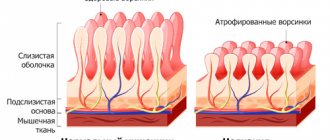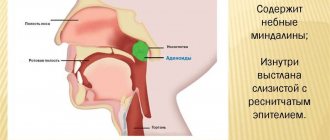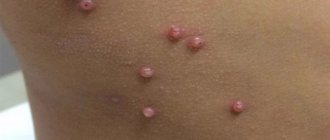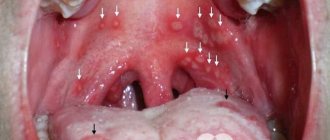| Parainfluenza belongs to a group of viruses called anthroponotic acute respiratory viral infection (HPIV - the common abbreviation or AARVI). This group includes four viruses, each of which causes different symptoms and illnesses. All forms of HPIV cause infections of the upper or lower respiratory tract in humans. |
Fast passage:
- Types of parainfluenza viruses
- Pathogenesis of parainfluenza
- Routes of transmission of parainfluenza
- Symptoms of parainfluenza
- Diagnosis of parainfluenza
- Treatment of parainfluenza
- Medicines for parainfluenza
- Prevention of parainfluenza
- How dangerous is parainfluenza?
The symptoms of HPIV are very similar to those of the common cold, and when the symptoms are quite mild, the viruses are often misdiagnosed. Most healthy people infected with HPIV recover without drug treatment. On the other hand, a person with a weakened immune system is at major risk, since the virus can cause a number of serious complications.
Types of parainfluenza viruses
There are four different types of HPIV. Although they all cause respiratory infections, the exact type of infection, symptoms, and location of the infection depend on the type of virus the person is infected with. Anyone can be affected by one of four types of HPIV.
- HPIV-1
HPIV-1 is the leading cause of croup in children. Croup is an inflammation of the larynx and upper airways, causing further narrowing of the airways. According to the Centers for Disease Control and Prevention (CDC USA), HPIV -1 is responsible for outbreaks of croup that occur in the fall. In America, outbreaks tend to be more common in odd-numbered years (according to the USA CDC).
- HPIV-2
HPIV-2 is also a cause of croup in children aged 3 months to 3 years, but its cases are much less common than HPIV-1.
- HPIV-3
HPIV -3 is often associated with bronchiolitis (swelling of the airways that reaches the lungs, one of the most severe respiratory diseases in young children) and pneumonia. Often, HPIV -3 is more common in the summer and spring, however, isolated cases of HPIV-3 are reported throughout the year.
- HPIV -4
There are two types of HPIV -4: HPIV -4A and HPIV -4B. HPIV -4 is extremely rarely included in mandatory tests. This omission is due to misunderstandings about its prevalence and its role in serious respiratory infections. Currently, no outbreaks of HPIV -4 have been reported.
Preventive measures
Good nutrition will help prevent croup syndrome. Thanks to a competent diet, it is possible to activate antibodies and slightly sensitize the body to many foreign agents. Dr. Komarovsky will talk about Parainfluenza in an interesting and informative video in this article.
Parainfluenza is an acute respiratory viral disease that affects the upper respiratory tract (mainly the mucous membrane of the larynx and nose). The disease is characterized by moderate intoxication, characteristic of typical colds.
Parainfluenza mainly affects children; among adults, the infection is much less common.
Pathogenesis of parainfluenza
The pathogenesis of the disease has not been sufficiently studied. It is known that the virus multiplies predominantly in the epithelial cells of the upper respiratory tract (nasal passages, larynx, and sometimes trachea). Localization of the process in the lower parts of the respiratory tract, small bronchi, bronchioles and alveoli is observed mainly in young children.
Patients develop hyperemia and swelling of the mucous membrane of the respiratory tract. Inflammatory changes are most pronounced in the larynx. Viremia in parainfluenza is short-term and is not accompanied by severe intoxication. The virus multiplies in the epithelial cells of the respiratory tract, destroying the cells in the process. Viruses and decay products of epithelial cells partially penetrate into the blood, which contributes to the development of fever and intoxication.
Prevention measures
There is no specific prevention of all forms of infection; there are certain measures to prevent the disease. You need to avoid contact with sick people, wash your hands often, and use an antibacterial spray. It is important to take vitamins, regularly do wet cleaning and ventilation of the room.
Parainfluenza
(from the Latin para - “about”) is an acute respiratory viral disease, clinically reminiscent of influenza, but differing from it in less intoxication, a longer course and more pronounced changes in the upper respiratory tract, mainly the larynx. Children are more likely to get parainfluenza.
Symptoms of parainfluenza
The general symptoms of all four types of HPIV are very similar to the common cold. They include:
- fever (sharp onset, temperature rises to 38°)
- cough
- runny nose
- stuffy nose
- chest pain
- a sore throat
- shortness of breath
- wheezing
- general difficulty breathing
Most often, the symptoms of parainfluenza viruses are not severe enough to cause concern in healthy adults. However, they can pose a serious threat to the lives of newborns and people with weak immune systems. In any case, if you feel the symptoms of parainfluenza, you must seek help from a doctor.
In people with chronic diseases of the respiratory system with parainfluenza, the process quickly spreads to the lower respiratory tract. Already in the first days of illness, symptoms of acute bronchitis are often observed. The most common complications of parainfluenza include pneumonia (pneumonia), which is caused by secondary bacterial flora and is usually inflammatory in nature. In children aged 3 months. – 3 years, sometimes croup develops.
Information about the disease and causes
The disease is caused by 3 main RNA viruses. Parainfluenza variants have an antigenic structure characterized by stability and lack of genome variability.
The causative agent of the disease is unstable to external factors; parainfluenza infection dies at a temperature of 18–20 ° C within a few hours, and when heated, it dies immediately.
Viruses that cause respiratory infections are sensitive to many disinfectants. The disease occurs at any time of the year, but the peak incidence occurs in winter and late autumn. Young children are most often affected.
The main route of infection with the parainfluenza virus is from a sick person. The patient becomes infectious on the last day of the incubation period, and then he can infect others for about a week after the onset of the disease.
The disease is transmitted in the traditional way, like most:
- when coughing;
- while sneezing;
- through kisses;
- through mucus or saliva.
Once in the respiratory tract, the infection settles, and after a certain time penetrates all the patient’s organs. The parainfluenza virus infects epithelium, resulting in a local inflammatory process.
With this cold, the doctor notes swelling of the patient's pharynx and accumulation of mucus in the nasal passages, which is manifested by a runny nose and sore throat.
When the pathogen enters the bloodstream, the process of intoxication begins:
- headache;
- temperature increase;
- refusal of food.
If the patient has a weakened immune system, complications may occur.
Diagnosis of parainfluenza
In most cases, the treating physician will not be concerned about whether the patient has HPIV. This is due to the fact that completely healthy people cope with this virus without additional treatment, so there is no need for an accurate diagnosis. However, if you have a weakened immune system, your doctor may want to check whether you have parainfluenza and what type it is to avoid serious complications such as bronchitis or pneumonia.
Most likely, your doctor can do a simple test to determine if your symptoms match those of parainfluenza. For a more accurate diagnosis, the doctor may take a swab from the throat or nose to determine the presence of the virus, particularly in the cell structure. A doctor can also determine the presence of the virus by detecting antibodies that the body produces to fight the virus.
On examination, the nasal mucosa is hyperemic and swollen. The soft palate and posterior wall of the pharynx are clearly hyperemic. Some patients experience fine granularity of the soft palate and slight swelling of the pharyngeal mucosa. There is an increase in heart rate and a corresponding increase in body temperature; in severe cases of the disease, there is a muffled heart sound.
Normocytosis or moderate leukopenia is detected in the blood. During the period of convalescence, monocytosis is possible; ESR is within normal limits.
To determine the extent of parainfluenza symptoms and determine whether complications such as pneumonia are present, your doctor may order a chest X-ray or CT scan of the chest. Both methods help doctors see exactly what is happening inside the patient's chest.
Possible complications
If parainfluenza is not treated, children may experience various complications, such as:
- angina;
- pneumonia;
- addition of a bacterial infection.
The occurrence of complications has a negative impact not only on the general health of the child, but also on his development. At the same time, the symptoms of intoxication of the body worsen.
If parainfluenza develops into pneumonia, then the body temperature can rise to 39 degrees, dizziness, severe weakness, and chills occur. The child develops a severe cough with the release of mucopurulent sputum, the pulse increases, and severe shortness of breath appears. Painful sensations when inhaling decrease if the patient lies on the side in which the pain is localized.
A more serious complication of parainfluenza is croup, which usually appears 3–5 days after the onset of the disease. The disease is severe and requires immediate hospitalization.
The addition of a secondary infection shows a general blood test: the ESR increases, leukocytosis with a shift to the left is noted (activation of the nonspecific immune system).
Treatment of parainfluenza
There are no specific treatment methods that can “remove” parainfluenza from the human body. With HPIV, you just need to let your body fight off the infection on its own.
Symptoms, however, can be treated with pharmacological medications such as nasal drops and analgesics such as aspirin or acetaminophen. Aspirin should not be given to a child or teenager who has signs of a fever or viral infection. Aspirin used as a treatment for viral illness in children is associated with Reye's syndrome, a serious and potentially fatal illness.
Medicines for parainfluenza
Since parainfluenza is a viral disease, the choice of medications is made in favor of broad-spectrum antiviral pharmaceuticals, for example:
- Arbidol, a drug that can be taken from 2 years of age. The dosage of arbidol from 2-6 years is 2 tablets per day before meals. At 6-12 years old, 4 tablets before meals. From 12 years old – 8 tablets. The drug should be taken for 5 days.
- Ribavirin / Virazole, a drug that can be taken from 12 years of age, the dosage of the drug is 10 mg/kg/day, the drug should be taken for 5-7 days.
- Isoprinosine – 50 mg/kg and the resulting dose is divided into 3 doses for 10 days, taken after meals.
- For local use, use Oxolinic ointment, put into the nose 2-3 times a day for 3-4 days, Lokferon - suppositories that are used rectally, the indication is the treatment of infectious and inflammatory diseases in children.
Immunomodulators can also be used to treat parainfluenza - these are universal virocidal drugs that suppress the replication (bifurcation) of DNA and RNA viruses, and also stimulate the body’s immunological reactions; such drugs may include, for example, Interferon-α / Viferon.
To relieve severe symptoms of the disease, the following medications can be used:
- antipyretics – Ibuprofen, Nurofen;
- for coughs, expectorants and mucolytics are prescribed - Lazolvan, Mucaltin;
- anti-inflammatory (relative to the respiratory tract) – Erespal;
- in the absence of treatment effect and exacerbation of symptoms, the attending physician may prescribe antibiotic therapy;
- for a runny nose (rhinitis), rinsing the nasopharynx with a weak saline solution or preparations based on it is prescribed.
Folk remedies
Juice treatment
- Recipe: 100 ml each of carrot and radish juice, 2 tsp. honey Mix juices, add honey. Mix the finished mixture thoroughly. When coughing,
take 1 tbsp. l. mixture every hour.
Treatment with honey
- Recipe: 1 large aloe leaf, 100 g honey. Dissolve honey in 0.5 cups of warm boiled water, add finely chopped aloe leaf. Place the mixture over low heat, bring to a boil and cook for 30–40 minutes, stirring constantly. Strain the hot mixture. When coughing, take 1 tbsp. l. (children – 1 tsp.) 3 times a day before meals.
How dangerous is parainfluenza?
For most people, HPIV goes away relatively smoothly. The symptoms may cause serious discomfort for a few days, however, you can only cope with the infection on your own if your immune system is functioning correctly.
Newborns, young children and the elderly, whose immune systems are weakened, are most at risk of parainfluenza infection and complications, so these categories of the population should definitely be examined by a doctor and receive clear instructions for effective treatment of the disease. However, with proper treatment, even such people recover quickly and completely.












